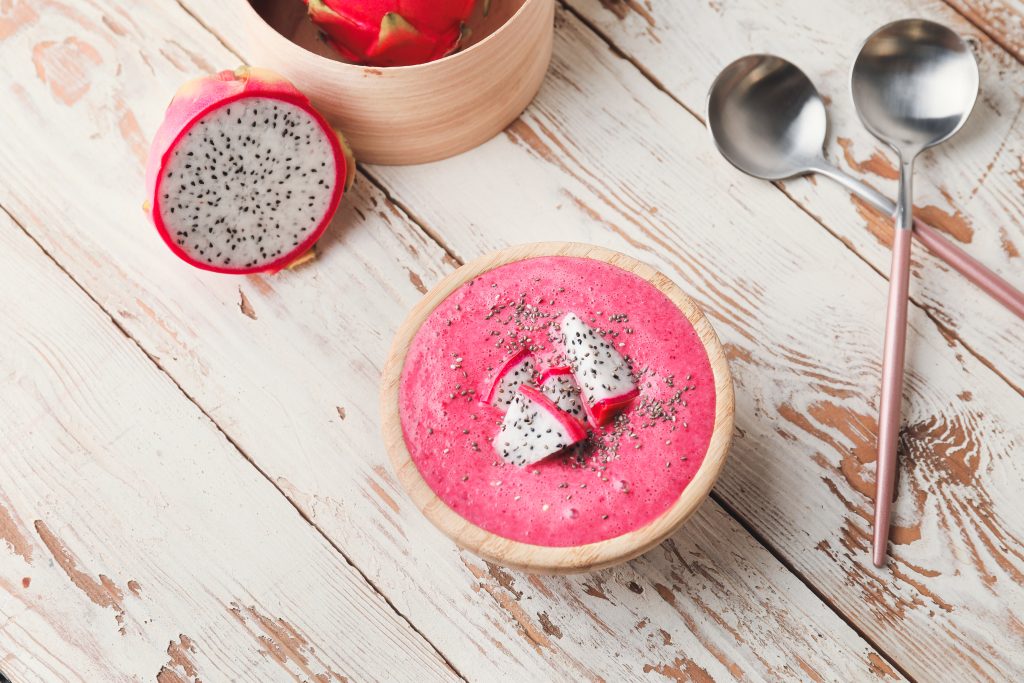Dragon fruit is a tropical fruit native to southern Mexico, Central America, and South America. Its unique appearance of vibrant yellow or pinkish-red skin with green scales resembles that of a dragon.
Table of Contents
What is a Dragon Fruit?
Dragon fruit is a tropical fruit belonging to the cactus family native to Central and South America. It is now also widely cultivated in Southeast Asia, specifically in Vietnam, Thailand, and Malaysia, as well as in some parts of Australia and the United States.
The red dragon fruit is oval or oblong, and its size can range from small to medium, around 10-15 cm (4-6 in) long. The outer skin is covered in thick, leathery, and spiky scales ranging from bright pink to red or yellow. The scales give the fruit a unique and exotic appearance, which makes it a popular choice for decorative purposes.
The flesh of the dragon fruit is white with edible tiny black seeds. The texture of the white flesh is similar to that of a kiwi, with a soft and juicy pulp that is mildly sweet and refreshing. Some people describe it as a combination of kiwi and pear, while others compare it to a cross between a strawberry and a watermelon.
Apart from the name “dragon fruit,” it is also known as “pitahaya” in Spanish, “buah naga” in Malay and Indonesian, and strawberry pear (in Asia). The two most common types of dragon fruit are the white and red-flesh varieties. Red-skin-white flesh dragon fruit is more common and slightly milder, while the red-fleshed variety is sweeter.
The scientific name of the dragon fruit, Hylocereus undatus, comes from three words: hyle (meaning woody) in Greek, cereus (meaning waxen) in Latin, and undatus (meaning wavy) in Latin as well, referring to the edges of its stems.

The History of Dragon Fruit
The origin of this fruit remains unknown, but it is believed to be from Central America. The French introduced the dragon fruit to Vietnam over a century ago.
Vietnam is the top exporter of dragon fruit worldwide, with 55 percent of the country’s fruit export revenues coming from this fruit in 2013. Since 2012, exports and growth areas of dragon fruit from Vietnam have continuously grown.
Other countries, such as Thailand, Israel, Northern Australia, Southern China, the Philippines, and Hawaii, are also attempting to cultivate this fruit.
What Does a Dragon Fruit Taste Like?
Dragon fruit has a mild, sweet flavor, often described as a cross between kiwi and pear, with a slightly crunchy texture. When eaten raw, the flesh of the dragon fruit is juicy and refreshing, with a subtle sweetness that is not overpowering. It is often eaten chilled or used as a garnish in fruit salads, bowls, smoothies, or other desserts.
Dragon fruit is not commonly cooked, but it can be grilled or baked, bringing out its sweetness and adding a slightly caramelized flavor. However, the texture of the fruit can become softer and less crunchy when cooked.
How to Tell When Dragon Fruit is Ripe
Here are some tips on how to tell when a dragon fruit is ripe:
| Color | A ripe dragon fruit will be bright and vibrant. There are some varieties, such as pink, red, or yellow dragon fruit, but the most common is the red-fleshed one. The color should be even throughout the fruit, without blemishes or discoloration. |
| Texture | A ripe dragon fruit will have a slightly soft texture, similar to a ripe avocado. Gently press on the fruit with your finger – if it gives slightly, it is likely ripe. However, it may be overripe if it is too soft or mushy. |
| Scent | A ripe dragon fruit should have a sweet, fruity aroma. If it has no smell, it may be unripe. If it has a sour or fermented smell, it may be overripe. |
Can I Eat Raw Dragon Fruit?
Yes, you can eat dragon fruit raw. In fact, it is often eaten raw as a snack or used in smoothies, salads, and other dishes. When eating dragon fruit, wash it thoroughly and cut it open to remove the flesh from the skin before consuming it.
There are some reported cases of allergic reactions to dragon fruit, so if you haven’t tried it before, proceed cautiously.
Cooking with Dragon Fruit
To prepare a dragon fruit, follow these easy steps:
- Wash it thoroughly and cut off both ends with a sharp knife.
- Slice the fruit in half lengthwise.
- scoop out the flesh with a spoon – the skin is not edible and should be discarded.
Dragon fruit is commonly eaten raw in salads, smoothies, and fruit bowls but can also be cooked in various ways. It is often used in Asian cuisine, mainly Vietnamese, Thai, and Filipino dishes.

Here are a few examples of dishes that use dragon fruit:
Dragon Fruit Salsa: This sweet and tangy salsa is perfect for pairing with grilled fish or chicken. Dice up some dragon fruit and jalapeño pepper, then mix with lemon juice and chives.
Dragon Fruit Smoothie Bowl: This colorful breakfast bowl contains nutrients and flavor – featuring raspberries, bananas, and dragonfruit. The result is a nutritious bowl with plenty of colors.
Dragon Fruit Salad: This salad will appeal to anyone who likes tropical flavors but also wants something different than what they usually see. It is a mix of sweet and savory flavors, with dragon fruit and other fruit of choice. The honey and fresh mind add warmth and freshness to this exotic treat.
Dragon Fruit Skin Jelly: This jelly is a popular low-calorie dessert made with dragon fruit, maple syrup, and agar agar. Ultimately, it will have that classic jiggly texture everyone loves about Jell-O.
How to Store Dragon Fruit
To keep your dragon fruit fresh and tasty, you have two options: Keep it at room temperature or store it in the fridge.
If you keep it at room temperature, find a cool and dry spot away from direct sunlight. You can leave it there for up to three days, but wait to wash or cut it until you’re ready to eat it.
If you prefer to keep your dragon fruit in the fridge, put it in a sealed plastic bag or container to avoid unwanted flavors from other foods. This way, your dragon fruit can last up to two weeks.
Nutritional Benefits of Dragon Fruit
The fruit of the dragon plant offers numerous potential health benefits and is very good for you. For one, it is packed with natural substances such as flavonoids, phenolic acid, and betacyanin, all of which function as antioxidants, shielding your cells from harm caused by free radicals. Thus, it prevents issues such as cancer and early aging.
Additionally, dragon fruit is naturally fat-free and has a high fiber content. As a result, it serves as a great snack to keep you feeling full between meals for extended periods. It may also help reduce blood sugar levels and the risk of type 2 diabetes.
Dragon fruit is also a good source of prebiotics and carbohydrates that promote the growth of beneficial bacteria in your gut, improving the balance between harmful and good gut bacteria in your intestines.
Dragon fruit is also abundant in vitamin C and other antioxidants that can help strengthen your immune system. It also has a healthy dose of iron, essential for transporting oxygen throughout the body.

Dragon Fruit Seed Oil
Dragon fruit seed oil is rich in essential fatty acids, particularly linoleic acid, which is known to help maintain the skin’s natural barrier and prevent water loss.
The oil extracted from the seeds of the dragon fruit is abundant in vitamins like vitamin E and vitamin C, as well as essential fatty acids such as omega 3, omega 6, and palmitic and oleic acid, which are all necessary to help protect the skin against environmental stressors and premature aging. As a result, this oil has gained a reputation as the ideal natural ingredient for anti-aging skincare products.
Where to Purchase Dragon Fruit
You can find dragon fruit at specialty food stores, health food stores, and Asian markets. It is also sometimes sold at farmers’ markets, although this will depend on the region and the season. In addition, some supermarkets now carry dragon fruit in the produce section.
Dragon fruit is typically available year-round in tropical regions where it is grown, such as Southeast Asia, Central and South America, and parts of the United States. However, the peak season for dragon fruit in the United States is June to September.
If you cannot find fresh dragon fruit in your area, it is also available in frozen and dried form in some grocery stores or online.

